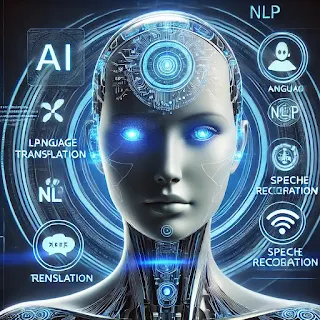Natural Language Processing (NLP) is a specialized domain within artificial intelligence (AI) that focuses on enabling machines to understand, interpret, and generate human language. By integrating computational linguistics with machine learning (ML) and deep learning methodologies, NLP has revolutionized various industries, enhancing communication, automation, and data processing capabilities.(Natural Language Processing (NLP): Advancements, Applications, and Future Prospects)
Core Components of NLP- NLP encompasses multiple components that contribute to the accurate understanding and processing of language. Key aspects include:
1.
Tokenization: The segmentation of text into meaningful units, such as
words or sentences.
2.
Lemmatization
and Stemming: Techniques used to reduce words to
their root forms for better analysis.
3. Part-of-Speech
Tagging (POS): The identification of grammatical
elements in a sentence.
4. Named
Entity Recognition (NER): The
extraction of essential information such as names, locations, and dates.
5.
Sentiment
Analysis: Assessing the emotional tone of
textual data.
6. Text
Summarization: Generating concise summaries from
large text corpora.
7. Machine
Translation: Automated translation of text
between different languages.
Recent Developments in NLP (2024 Update)- Significant advancements in NLP have been driven by deep learning, large-scale models, and improved computational power. Some of the most notable updates include:
1. Evolution of Large Language Models (LLMs)- Advanced models such as GPT-4, Claude, Gemini, and Mistral have set new benchmarks in natural language understanding and generation. These models demonstrate enhanced contextual awareness, improved reasoning, and superior text synthesis capabilities.
2. Integration of Multimodal AI- The emergence of multimodal AI has enabled NLP systems to process and interpret multiple data types, including text, images, and speech. Notable developments include OpenAI’s GPT-4 Turbo and Google’s Gemini 1.5, which provide more dynamic and interactive AI experiences.
3. Expansion of Low-Resource Language Processing- Recent advancements in few-shot and zero-shot learning have improved NLP applications for underrepresented languages, ensuring broader accessibility and inclusivity in AI-driven communication.
4. Enhancement of Conversational AI- Sophisticated AI-driven conversational agents are transforming customer support services. AI chatbots such as ChatGPT, Bard, and Claude are becoming increasingly adept at handling complex inquiries, reducing human intervention in customer interactions.
5. NLP in Healthcare- The healthcare industry is leveraging NLP for clinical documentation, medical chatbots, and pharmaceutical research. AI-driven solutions facilitate the extraction of critical information from patient records, aiding in diagnostics and decision-making.
6. Ethical Considerations and Security Enhancements- To mitigate risks associated with AI-generated misinformation and bias, researchers are prioritizing ethical AI, fact-checking mechanisms, and explainable AI frameworks to ensure transparency and fairness in NLP applications.
Industry Applications of NLP- NLP’s influence spans across diverse industries, optimizing operational efficiency and enhancing user experiences.
- Search Engines:
Algorithms in Google, Bing, and other search platforms leverage NLP for
improved search accuracy.
- Voice Assistants:
AI-powered systems such as Alexa, Siri, and Google Assistant utilize NLP
for speech recognition and response generation.
- Finance and Banking:
Automated customer support, fraud detection, and risk assessment rely on
NLP-powered analytics.
- Legal Sector:
AI-driven contract analysis and legal research streamline documentation
and compliance processes.
- Content Generation: NLP-based tools assist in automated writing, summarization, and content creation for digital media. Challenges in NLP- Despite its advancements, NLP faces several challenges that require ongoing research and development:
1.
Language
Ambiguity: Contextual variations in human
language can lead to misinterpretation.
2.
Bias in AI
Models: AI systems may inherit biases from
training datasets, affecting decision-making processes.
3.
Computational
Constraints: The development of sophisticated
NLP models requires significant computational resources.
4.
Privacy
and Data Security: Handling sensitive data raises
ethical and regulatory concerns.




.jpeg)



.jpeg)



0 Comments